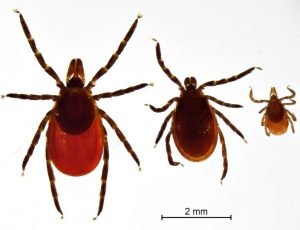
Tick populations are growing in Illinois, partly because of warmer weather and changes in the environment. Researchers have identified at least 15 different tick species in the state, some of which can carry diseases that impact human and animal health.

Ticks have eight legs and are relatives of spiders, making them members of the class of creatures known as arachnids. A tick is comprised of two segmented parts: the head and body. The top of the tick’s head contains a needle-like projection, which the tick uses to puncture its hosts and feed. Living hosts, including humans and animals, are a tick’s main source of food.
Ticks can carry a variety of diseases such as Lyme disease, Ehrlichiosis, Rocky Mountain spotted fever, Anaplasmosis, and Babesiosis. When a disease-carrying tick feeds on its host, it may transmit infections that make people sick.
The longer a tick is attached to a host, the greater the risk of it passing along diseases. However, the transmission of certain tick-borne diseases may happen even if a tick was attached for a short time period.
Ticks can reside in a variety of Illinois habitats. Some common ones include:
Ticks may be present in rural, suburban, and urban areas, at local parks, nature preserves, campgrounds, and hiking trails. Ticks can thrive in a variety of outdoor conditions and environments.
Your best defense against tick bites is to minimize your risk of coming in contact with them. Ticks can be active all year round, but you’re more likely to encounter them during the warmer months (April through September).
Here are some steps you can take to help prevent tick bites.
Gear up for protection. Treat your clothing and gear with 0.5% permethrin to repel and kill ticks. You can spray it on shoes and boots, clothing, backpacks, and camping gear, which will last through multiple washes. You can also opt for pre-treated items for added convenience.
Stay on path. Stick to maintained pathways or walk in the center of trails. Avoid wooded and grassy areas when possible and stay vigilant for possible tick habitats such as tall grass, overgrown or unkempt grass, or leaf litter piles.
Use tick repellent. Apply EPA-registered insect repellents containing DEET, picaridin, IR3535, or oil of lemon eucalyptus on exposed skin. Follow the product instructions to ensure safety and effectiveness.
Examine your clothes for ticks. Ticks can hitch a ride on your clothing, so check them carefully after being outdoors. Remove any ticks you find, and tumble dry your clothes on high heat for 10 minutes to kill remaining ones. For damp clothes, allow extra time. If you need to wash your clothes, use hot water. Ticks can survive in cold or medium temperatures.
Check your gear and pets. Ticks can latch onto pets, backpacks, and outerwear and make their way into your home. Check your pets, coats, and gear thoroughly to prevent ticks from catching a ride indoors.
Take a shower. When you return indoors, shower within two hours to decrease your risk of Lyme disease and other tickborne diseases. This helps wash away unattached ticks and gives you a chance to thoroughly check for any ticks hidden on your body.
Perform tick checks. Conduct full-body tick checks. Don’t forget to examine hard-to-see areas, such as around your hairline, in and behind your ears, and the back of your knees. Check your gear and pets for ticks as well.
The Illinois Natural History Survery Medical Entomology Lab at the University of Illinois, Urbana-Champaign provides free tick identification and passive tick surveillance for Illinois residents. Note: This program is for research purposes only.
The information obtained from this statewide program helps provide identification and preservation of tick species throughout Illinois. It also helps inform researchers and health officials of where and when different ticks occur in Illinois.
For more details on this statewide program, visit the Illinois Natural History Survey Medical Entomology Lab.




The Wildlife Illinois website was authorized by the Illinois Department of Natural Resources (IDNR) in partial fulfillment of project W-147-T. The website was developed by the National Great Rivers Research and Education Center, 2wav, and the IDNR in partnership with the United States Department of Agriculture Animal and Plant Health Inspection Service Wildlife Services and University of Illinois Extension to provide research-based information about how to coexist with Illinois wildlife.